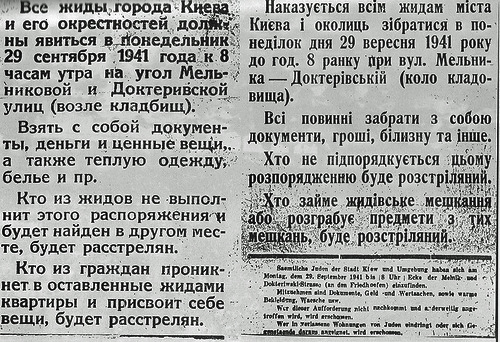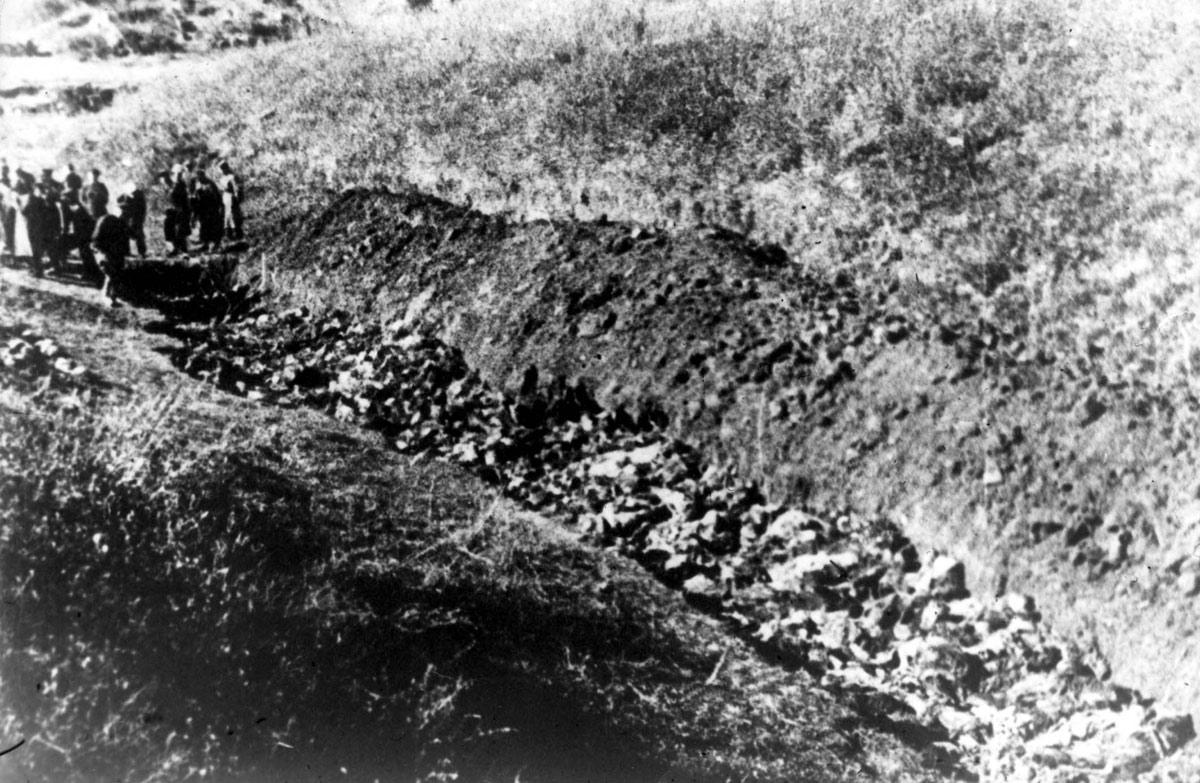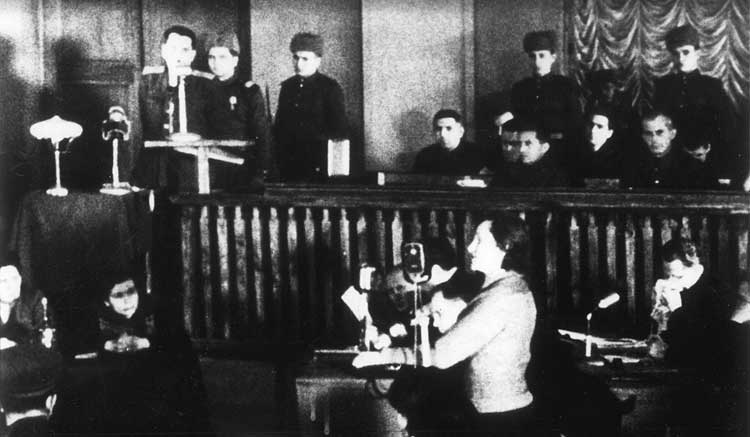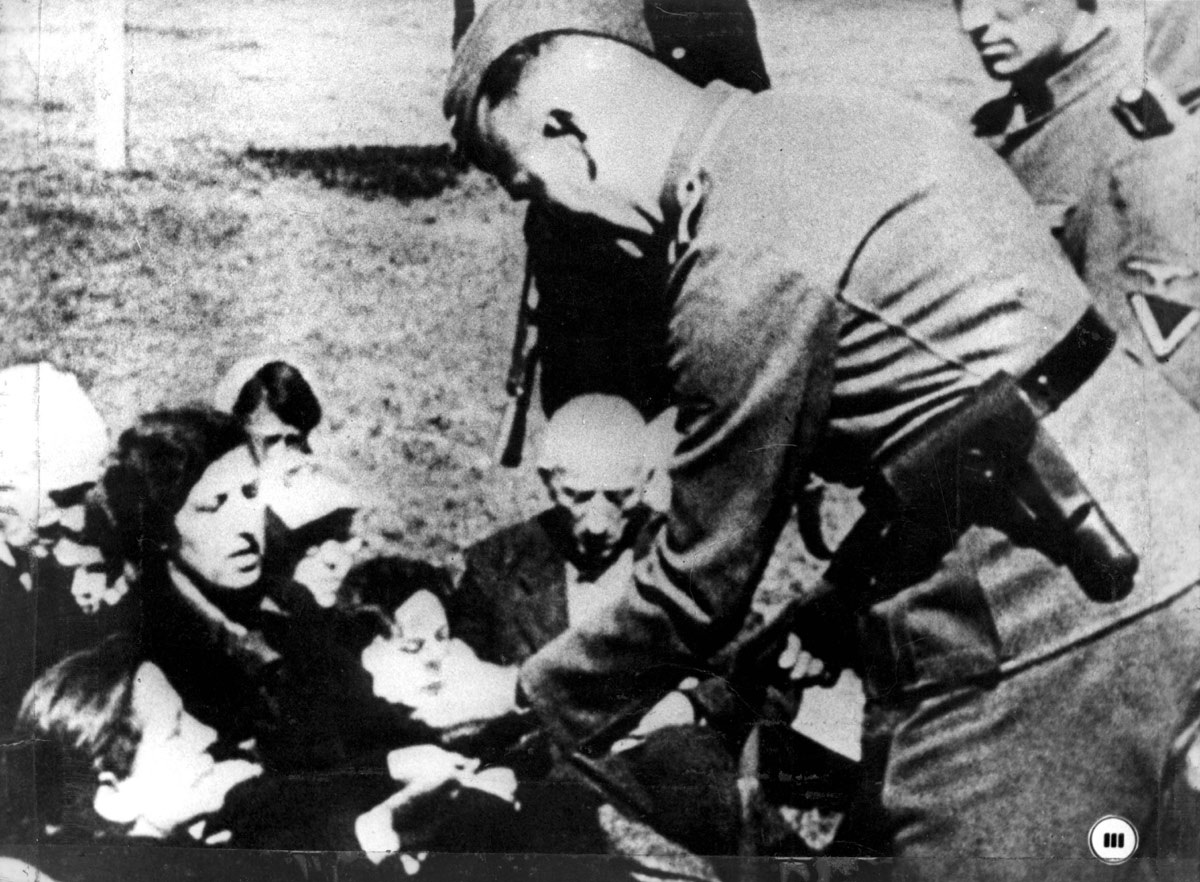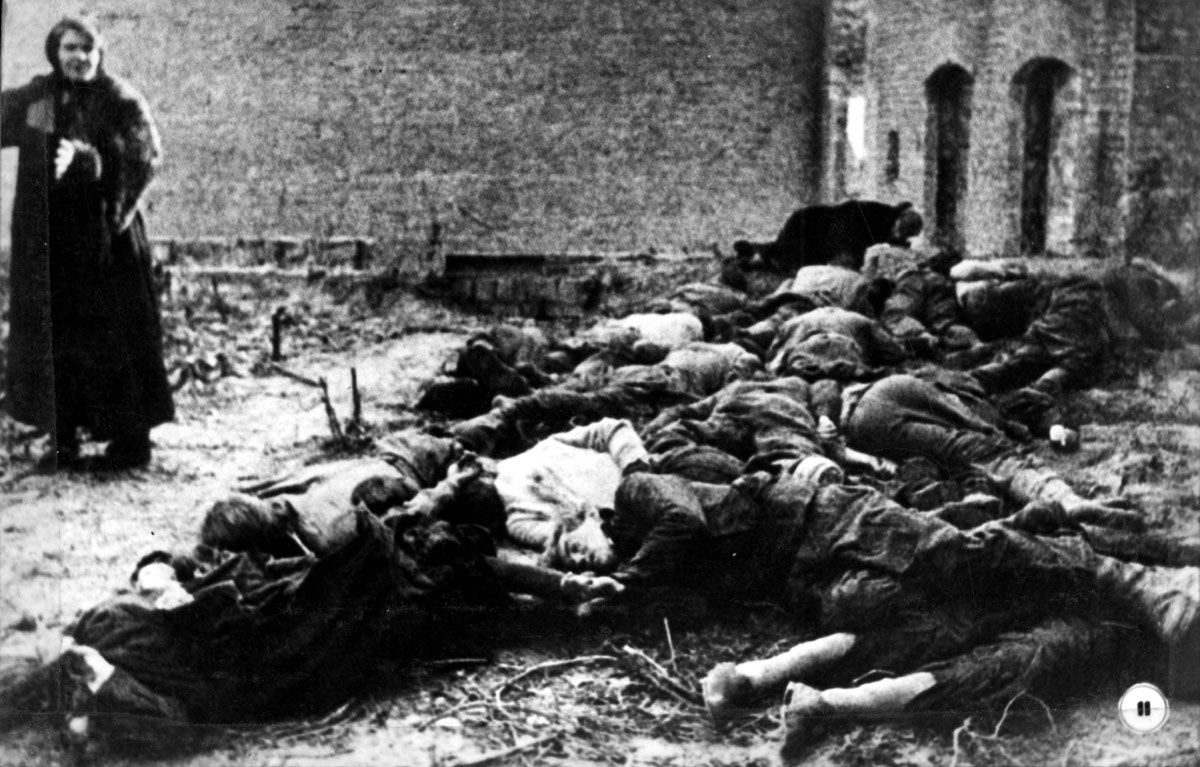In the territories that belonged to the Soviet Union before 1939, mass extermination of the Jews was usually organized very soon after the occupation of a locality. Thus, in Kiev, only 10 days – from 19 to 29 September 1941 – passed between the occupation of the city and the start of the physical annihilation of the local Jews in Babi Yar.
On the eve of Operation Barbarossa, about 230,000 Jews lived in Kiev, including refugees from the Polish territories occupied by Germany. After many Jews were drafted to the front, evacuated or escaped, at the time when the city was taken by the German troops on 19 September 1941, 60 to 70 thousand, according to various estimates, still remained in the city. Most of them were women, children and the elderly.
On September 24, a few days after the occupation of the city by the Germans, NKVD mopping-up detachments left behind the lines blew up the buildings of the army headquarters, commandant’s office and visiting officers’ quarters in Kiev’s main street – Kreschatik, which had been rigged with explosives even before the retreat of the Red Army. On September 26, at a meeting convened by the field commandant of Kiev, Kurt Eberhard, it was decided that the responsibility and punishment for the explosions should fall on the Jews of Kiev.
On September 28, the following announcements in Russian, Ukrainian and German were pasted up all over the city:
"All the Yids of the city of Kiev and its vicinity must appear on Monday September 29, 1941 by 8 a.m. at the corner of Melnikova and Dokhterivskaya streets (next to the cemetery). Bring documents, money and valuables, and also warm clothing, bed linen etc. Any Yids who do not follow this order and are found elsewhere will be shot. Any civilians who enter the dwellings left by Yids and appropriate the things in them will be shot".
The text of the announcement deserves special attention: it is a typical example of a trick widely used by the Nazis to deceive and confuse the victims before the execution. It is impossible to understand from the announcement that the Jews are in mortal danger. The order to take documents, money, valuables, warm clothes and bed linen seems to mean that it’s about resettlement. In addition, there were rumors circulating around the city to the effect that the Jews would be sent from Kiev somewhere else. The ban on entering apartments left behind and appropriating Jewish property creates an illusion of protection: ostensibly, Jewish property will be safe and will await the return of its owners. At the same time, the announcement contains a threat of punishment by death for disobeying. It is no wonder, therefore, that many Jews believed it would be safer to comply and come at the appointed time to the meeting point.
It is also worth noting that September 29 was not an accidental choice – in 1941, Yom Kippur fell on that day. Arranging the mass executions of the Jews on the days of Soviet or Jewish holidays was a frequent occurrence and had symbolic meaning of triumph for the Germans.
In the morning of September 29, Jews of Kiev started to gather in the appointed place.
A resident of Kiev, teacher L. Nartova, described it in her diary on September 29, 1941:
September 29, 1941
I went out to the balcony. I saw a crowd of Jews, guarded by four policemen, going along the street. They were of different ages, but mostly elderly. They were walking slowly and with such pitiful faces that it was difficult to look at them. All of them looked ill. Three women were carried behind them on wheelbarrows. Their legs were hanging out and striking the pavement. Oh, how terrible it is to live here, how difficult it is to watch this scene. I wanted to run away. I got dressed, and went out to the street just at the time when they were even with our house. They were ill or crippled and policemen were guarding them.
I happened to meet a little girl … who also could not take her eyes off them. She asked me: "Auntie, are they Jews? Where are they being driven? Are they going to be killed?"
Her eyes were opened wide. It was obvious that such a possibility could not enter her head. Into whose head of ours could it?"1
The local auxiliary police escorted the Jews to Babi Yar, a natural ravine on the outskirts of the city, where they were shot. According to the Einsatzgruppe C reports, 33,771 Jews were killed in Babi Yar over the course of two days, September 29 and 30:
- 1. TsGAOOU, 1-22-347, copy YVA M.37/43
"The bitter hostility of the Ukrainian population against the Jews is extremely great, because it is thought that they were responsible for the explosions in Kiev. They are also seen as NKVD informers and agents, who unleashed the terror against the Ukrainian people. All Jews were arrested in retaliation for the arson in Kiev, and altogether 33,771 Jews were executed on September 29th and 30th. Gold, valuables and clothing were collected and put at the disposal of the National-Socialist Welfare Association (NSV), for the equipment of the Volksdeutsche, and part given to the appointed city administration for distribution to the needy population".
R-102.2
Here is the description of the events by Dina Pronicheva, one of the few who managed to escape from Babi Yar:
- 2. Yitshak Arad, Yisrael Gutman, Abraham Margaliot, eds., Documents on the Holocaust, Jerusalem, 1981, p. 416.
"My name is Dina, Dina Mironovna Vasserman. I grew up in a poor Jewish family, was raised under Soviet rule in the spirit of internationalism and, thus, it is no wonder that I came to love a Russian boy, Nikolai Pronichev, married him, [and] lived with him in love and happiness. In that way I became Dina Mikhailovna Pronicheva. My [internal] passport identified me as a Russian. We had two children - a boy and a girl…
Hitler's troops occupied Kiev on September 19, 1941 and from the very first day started to rob and kill Jews… We were living in terror. When I saw the posters on the city’s streets and read the order: “All the Jews of Kiev must gather at Babi Yar,” about which we had no idea, in my heart I sensed trouble… So I dressed my little ones, the younger one [the girl] who was 3 years old and the older one [the boy] - 5, packed their belongings into a small sack, and took my daughter and son to my Russian mother-in-law. Afterwards, I took my sick mother and, following the order, she and I started out on the way to Babi Yar.
Hundreds, no thousands, of Jews were walking the same way. An old Jew with a long white beard walked next to me. He wore a talis [prayer shawl] and tefillin [phylacteries]. He was murmuring quietly. He prayed the same way as my father did when I was a child. Ahead of me a woman with two children in her arms walked along, while the third child clung to her apron-strings… Small children were crying… Russian husbands accompanied their Jewish wives. Russian wives accompanied their Jewish husbands. When we neared Babi Yar, shooting and inhuman cries could be heard… When we entered the gate, we were ordered to hand over [our] documents and valuables, and to take off our clothes. One German approached my mother and tore her gold ring off her finger. Only then did my mother say [to me]: “Dinochka-you are Pronicheva, a Russian. You should save yourself. Run to your little ones. You should live for them.”
But I could not run… How could I leave my mother alone? I hugged her, burst into tears, but I could not leave her.
My mother pushed me away from her, crying: “Go quickly!”
I then approached a table where a fat officer was sitting, showed him my passport, and said quietly: "I am a Russian."
He looked closely at my passport, but at that moment a policeman came running up and muttered: "Don't believe her, she is a kike. We know her…"
The German told me to wait and to stand aside.
Each time I saw a new group of men and women, elderly people, and children being forced to take off their clothes. All [of them] were being taken to an open pit where submachine-gunners shot them. Then another group was brought…
With my own eyes I saw this horror. Although I was not standing close to the pit, terrible cries of panic-stricken people and quiet children’s voices calling “Mother, mother…” reached me. The German who ordered me to wait brought me to some superior of his, gave him my passport, and said to him: "his woman says she is a Russian, but a policeman knows that she is a kike."
The superior took the passport, examined it for a long time, and then muttered: "Dina is not a Russian name. You are a kike. Take her away!"
The policeman ordered me to strip and pushed me to a precipice… But before the shots resounded, apparently out of fear, I fell into the pit. I fell on the [bodies] of those already murdered…. During the first moments I couldn't grasp anything - either where I was or how I got there… I pretended to be dead…
The shooting was continuing and people kept falling…
Suddenly all became quiet. It was getting dark… I felt we were being covered with earth… When it became dark and silent, literally the silence of death, I opened my eyes and threw the sand off me… I said to myself: “Dina, stand up. Get away. Run from here, your children are waiting for you.” So I stood up and ran, but then I heard a shot and understood that I had been seen. I fell to the ground and remained silent. It was quiet. Still on the ground, I started to move quietly toward the high hill[s] surrounding the pit…"3
Those Jews who were not murdered during the two-day massacre of late September 1941 were locked up in garages on Melnikova Street near Babi Yar. These Jews were murdered in Babi Yar by members of Einsatzkommando 5 on October 1-3, 1941.
Not all Jews, however, obeyed the order. Thousands remained at home or tried to hide. Zakhar Trubakov, a Jew from Kiev, remembered:
"On that day of doom I went with everybody just to make sure I was right. Nothing good could come out of the idea of gathering all the Jews together… This certainty never left me. I was walking slowly, trying to find people I knew in the crowd. Many were in a hurry, because there were rumors of people being loaded onto railway cars, and lots of people walked faster than me. I reached the Pugachev Street, heard shots from the direction of Babi Yar and realized what they meant… So, I was right and the Nazis were not going to spare us… I easily slipped out of the flow of people and returned home with a heavy feeling. Something unprecedented was happening to me. I could not sit still, I wept over those who had gone unthinkingly towards their certain deaths...
There is an opinion that all the Jews of Kiev went to the indicated address, and from there – to Babi Yar. But I do not agree with this opinion. I did not go myself and urged others as best I could not to go. I told many people how the Nazis had murdered the Jews of Minsk – the capital of Byelorussia. People listened but, as often happens, did not hear. They answered that they had nowhere to hide, especially those with little kids. And many simply refused to believe the worst… "4
Jews who tried to hide were captured and killed in Babi Yar for a long time after that.
German commandment and nationalist Ukrainian newspapers demanded from the residents of Kiev to denounce the Jews. In one of the issues of the “Ukrainskoe slovo” newspaper from October 1941, there was an article that said the following:
"The Yids who still remain in Kiev pretend to be people of other ethnic backgrounds – Greeks, Armenians, Ukrainians, Russians; they pay hundreds of thousands of rubles for the appropriate documents. But Ukraine has many true patriots, who are dreaming to cleanse their life, their villages, thick forests and beautiful cities as soon as possible from partisans, inciting Yids, and red Commissars. These patriots come every day to the little house on the Shevchenko Boulevard (Gestapo) and give information about the enemies".5
The administration of the Ukrainian police of Kiev issued a decree that obligated all house-managers and yard-keepers to inform the nearest police station about Jews residing in their houses. The decree also stated that hiding Jews was punishable by death. Thus, yard-keepers and house-managers were personally responsible for carrying out the order under threat of death. In addition, obeying the order was made easier by the fact that since the Soviet times, they had lists of all the dwellers that included not only names but ethnic backgrounds as well. Many Jews who tried to find shelter away from their homes were also often given away (often because of fear of punishment).
After the war, at the trial of war criminals, a former officer of the German security police Erich Ehrlinger testified about a vast number of denunciations:
"…there were still many Jews living in hiding in the Kiev metropolitan area. Loads of denunciations [revealing the location] of hidden Jews by the Ukrainian population hostilely disposed toward the Jews arrived at the office of the commander of the Security Police [of Kiev]. The number of denunciations was so large that the office was unable to process them all due to the lack of personnel".6
In total, over the period from September 29 to October 11, according to various estimates, over 50,000 Jews were shot.
In November 1941, about 300 Jewish patients of the St. Cyril mental hospital were also murdered in the grove close to Babi Yar.
Throughout the period of the German occupation, the Nazis continued to kill Jews and other victims of the occupational regime captured in Kiev and its vicinity, bringing them to Babi Yar and the Syrets camp (built in 1942 a few hundred meters from the ravine).
The fate of Soviet prisoners of war who were Jews was different from the plight of other POWs (who were treated abominably as well) in that they had practically no chances to survive – as a rule, the Germans separated them from the others and shot them soon after taking them captive. Thus, in Kiev, Soviet Jewish POWs were killed in Darnitsa on the left bank of the Dnieper, and in Kiev Pechersk Lavra (Monastery of the Caves).
In June 1942, the Germans started “Operation 1005” – a large-scale secret operation to destroy the evidence of the mass murder by the Nazis of the European Jews; the operation continued until the end of 1944. The commanding officer of Sonderkommando 4a of Einsatzgruppe C, Paul Blobel, was in charge of the operation.
In August 1943, “Operation 1005” began in Kiev. A group of male prisoners from the Syrets camp – Jews and non-Jews – were made to dig up and burn the bodies of victims in Babi Yar. On September 29, 1943, these prisoners (327 men) raised a revolt and attempted to escape. Only 18 men managed to flee and survive; all the rest were shot. Among those who escaped was Zakhar Trubakov. He remembered:
"When we got to the exit, we found it was blocked. There was a sub-machine gunner on top of a dugout, and he was shooting at us… No, we must not run blindly into fire! I set my hands against the door post and held everyone who was pushing from behind. I realized clearly how easy it was to get hit by a bullet and was waiting for the right moment. And, oh miracle! – it came. As soon as the German began to change the stick magazine of his submachine gun, we darted forward, past dozens of killed men…
All this happened in the dead of night, in the fall. Only when I found myself beyond the fence, in relative safety, I thought that if I should stay alive I must remember the date: September 29, 1943. Much later, after the war, I was surprised to recollect that it was exactly two years before our daring escape – on September 29, 1941, – that the murders of Jews in Babi Yar had begun". 7
- 7. Zakhar Trubakov, The Secret of Babi Yar. "Krugozor", 1997 (Russian).
Not only Jews were murdered in Babi Yar. The first victims of the Nazis here were the patients of the Kiev psychiatric hospital, on 27 September 1941. Later, the Nazis used this site to shoot Soviet POWs, partisans, resistance members, communists and gypsies, as well as Ukranian nationalists after the attitude of the Nazis towards them changed. The total number of people murdered in Babi Yar is estimated at 70,000 to 100,000.
The Red Army liberated Kiev on November 6, 1943. The German occupation of Kiev lasted slightly over two years, and by the end of this relatively short period, only a few out of approximately 70 thousand Jews of the city remained alive. The tragedy of Babi Yar became a symbol of anti-Jewish policy and extermination not only of the Ukrainian Jews, but all Soviet Jews who found themselves under the occupation.
Killers and their accomplices
Most of the Jews of Kiev were exterminated by Einsatzgruppe C under the command of Brigadeführer Otto Rasch. In particular, Sonderkommando 4a, commanded by SS-Standartenführer Paul Blobel, carried out the executions in Babi Yar in September 1941 and the subsequent murders of the Jews of Kiev.
Wehrmacht units and auxiliary Ukrainian police also took part in the extermination of the Jews of Kiev. Einsatzgruppen were relatively few in numbers and could not achieve their goals without additional help. Therefore, in addition to Einsatzgruppe C that was active in the territory of Reichskommissariat Ukraine, military divisions of the SS (“Waffen-SS”), battalions of the Ordnungspolizei and gendarmerie, soldiers of Wehrmacht and local auxiliary police all took part in murder operations.
The extermination policy towards the Jews was part of Germany’s general occupational policy in the USSR and was directed by the Germans; nevertheless, local collaborationists played an important role in the extermination of the Jews. They knew the local population, could easily tell the Jews from the rest, and it was therefore local councils and local police that were entrusted with registering the Jews, escorting them to the murder site, and cordoning off the site itself. Many local residents were ready to collaborate with the Germans. Involvement of the locals in persecution and extermination of the Jews was systematic and on a mass scale.
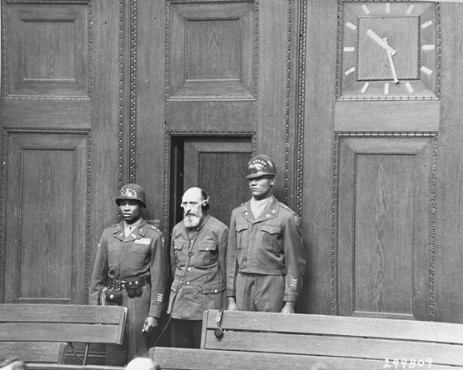
Paul Blobel, former commanding officer of Sonderkommando 4A of Einsatzgruppen 'C', is sentenced to death by hanging at the Einsatzgruppen Trial.
Historian Alexander Prusin8, who researched the motives of collaborationists in the occupied territories of the USSR, evaluated the social and ideological profile of the Ukrainian policemen using the example of the Kiev general district. Out of 82 court cases of former policemen, 73 were Ukrainians, six – Russians, two – Germans, and one was Polish, which corresponds to the ethnic demographics of central and eastern Ukraine. They were from different socio-economic classes, but only some of them had higher education. Only few of the cases reveal ideological motive for the actions of collaborationists. The two largest groups are those whom the researcher calls “conformists with initiative” (26 men) and “ordinary foot soldiers” (42 men).
In other words, most collaborationists were not members of any nationalist organizations, and their behavior was not governed by ideological impulses. As a rule, their motivation was different, more down-to-earth: gaining material benefits, prospects of career advancement under the new regime, fear of punishment, perception of police service as a way to survive in the difficult conditions of the occupation, settling of old scores, and, of course, greed – expectation of appropriating and plundering the victims’ property.
Prusin notes that, although the local police forces established by the Germans in Ukraine were rather large in numbers, they were no more than one percent of the total population. However, he emphasizes that their role must be viewed not through the prism of numerical relations but in the context of their actions in the system of the German occupation. Without the active cooperation of the local police, the Germans would have been unable to annihilate so many people in such a relatively short time.
After the end of the war, trials were held of the war criminals responsible for the mass murders in Babi Yar. Some of those trials took place in Kiev; for example, Dina Pronicheva’s story quoted above was part of her testimony during a trial on January 24, 1946.
Other trials were held in Nuremberg. In 1948, an American military court in Nuremberg sentenced Paul Blobel to death. The sentence was carried out in June 1951.
Otto Rasch was also arrested and in September 1947 was brought to trial in Nuremberg as a defendant in case against the Einsatzgruppen. Rasch’s case was discontinued because of his health problems. He died in jail on November 1, 1948.
The reaction of the non-Jewish population to the extermination of Jews
The situation that was characteristic for the Soviet occupied territories on the whole, was typical for Kiev as well. Due to the reasons provided in the section "War Against the USSR and the Anti-Jewish Policy in the Occupied Soviet Territories", the reactions of the non-Jewish neighbors to the extermination of the Jews varied. Most of the people were passive in the face of what was happening to the Jews. Some were indifferent, others gloated and were content to think that they would finally get rid of “those Yids”. Some of the locals directly participated in the persecution and extermination of the Jews. There were also a few who, despite mortal danger, tried to help the Jews.
It is worth noting that the reaction of the local non-Jewish population to the anti-Jewish policies often changed when it came to mass murders. Here is what the writer Anatoli Kuznetsov says about September 28, 1941, the day before the executions in Babi Yar:
"My grandfather… came rushing into the room:
'I've got great news for you! ... From tomorrow there won't be a single Yid left in Kiev. It seems it's true what they said about them setting fire to the Kreshchatik. Thank the Lord for that! That'll put paid to them getting rich at our expense, the bastards. Now they can go off to their blessed Palestine, or at any rate the Germans'll deal with 'em. They're being deported! There's an order posted up.'
We all dashed outside. A notice printed on cheap grey wrapping-paper, with no heading and no signature, had been stuck on the fence:
' All Yids living in the city of Kiev and its vicinity are to report by 8 o'clock on the morning of Monday, September 29, at the corner of Melnikovsky and Dokhturov Streets (near the cemetery). They are to take with them documents, money, valuables, as well as warm clothes, underwear, etc…'
…I read it over twice, and for some reason it made me shudder. It was written so very harshly, with a sort of cold hatred…
Did that mean that Shurka Matso would also have to go?.. I began to feel sorry for him, sorry to have to part from him forever.
Then suddenly - to my surprise, sort of spontaneously – I began to talk to myself in my grandfather's words, with that same intonation and malice: So what? Let 'em go off to their Palestine.
They've grown fat enough here! This is the Ukraine; look how they've multiplied and spread out all over the place like fleas. And Shurka Matso – he's a lousy Jew too, crafty and dangerous. How many of my books has he pitched! Let 'em go away; we'll be better off without 'em – my Gramp is a clever chap, he's right."9
But the grandfather changed his mind about what was going on after it became clear that the Jews were not being deported but shot. Here is what Anatoli Kuznetsov writes further:
"When I got home I found my grandfather standing in the middle of the courtyard, straining to hear some shooting that was going on somewhere. He raised his finger.
'Do you know what?' he said with horror in his voice. 'They're not deporting 'em. They're shooting 'em.'
Then, for the first time, I realized what was happening.
From Babi Yar came quite distinctly the sound of regular bursts of machine gun fire: ta-ta-ta, ta-ta...
It was the sort of rather quiet, unexcited, measured firing you heard when they training…
Grandpa looked puzzled and frightened.
'Maybe it's fighting?' I suggested.
'That's not fighting!' Gramp shouted plaintively. 'The whole of Kurenyovka is already talking about it. Some folk have climbed trees and seen what's going on. Viktor Makedon ran all the way back; he went down with his wife, she's a Jewess, and he only just escaped being taken himself. Oh, Mother of God, Queen of Heaven, what is this, why do they do that to them?'
…It was cold outside; there was a biting wind blowing, like the previous day. All the same I went outside and strained my ears. Grandma brought out my coat and hat and also stood listening and wringing her hands and muttering: 'Oh God, there are women and small children there…' I had the impression she was crying."10
The Jews who managed to escape death and were trying to hide were completely dependent on the people around them. Even the smallest violation of secrecy could result in dire consequences. As has been noted above, informers were plenty.
Zakhar Trubakov, who disobeyed the order about going to the meeting point before deportation to Babi Yar on September 29, 1941, and thus avoided the execution, kept his illegal presence in the city strictly confidential. His wife Anya, a Ukrainian woman who had no need to hide, was with him. Trubakov remembered:
"The only thing I gave Anya a very strict warning about was not to tell any of her acquaintances that I was there, in Kiev. For many knew that I was Jewish. And one careless word was enough for me to be taken to Gestapo to be checked… And there…
But the thing I feared most did come about. One day she met her old friend, Lyalya Tomskaya, and, forgetting my warnings, brought her to our home. When Lyalya saw me, she went bug-eyed with surprise: “Zyama, you’re hiding here, in Kiev? But it’s dangerous!”
What could I do? I entreated her:
- Please keep silent and don’t tell anyone you know that you have seen me.
Further events showed that my words and entreaties had little effect on the young woman… She told everything in secret to her mother, who wrote a denunciation about me. In order not to arouse suspicion, that vile woman ordered her younger daughter to take the paper to Gestapo.11
There were, however, examples to the reverse, when the locals rescued Jews despite the related risk to life. Thus, Yente Petrovskaya and her six-year-old son, instead of obeying the order and going to the meeting point close to Babi Yar, were hiding for a few days in their own apartment, until one of the neighbors denounced them to the authorities. Yente and her son managed to escape. They went to people they knew: Grigoriy Chaplinsky, his wife Nadezhda and their 15-year-old son Anatoly. The Chaplinskys gave them shelter and hid them until the liberation of Kiev on November 6, 1943. During the time of the occupation, the Chaplinskys and their “guests” moved from one apartment to another several times, so as to avoid neighbors’ suspicions. After the war, the rescued Jews and their rescuers remained close friends.
- 8. Alexander Prusin, Ukrainian Police and the Holocaust in the Kiev General District, 1941–1943: Actions and Motivations, http://www.holocaust.kiev.ua/z2/Articles_Prusin.pdf (Russian).
- 9. A. Anatoli (Kuznetsov), Babi Yar, transl. David Floyd, Washington, 1970, pp. 66-68.
- 10. Ibid., pp. 71-72.
- 11. Zakhar Trubakov, The Secret of Babi Yar. "Krugozor", 1997 (Russian).
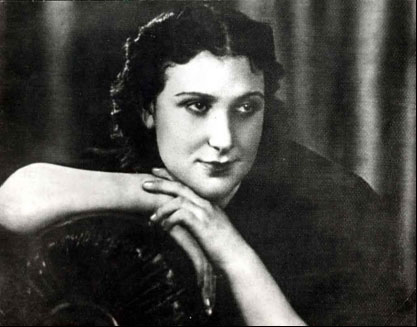
Tatiana Markus, Anti-Nazi Resistance Fighter in Kiev
Resistance
Jews took an active part in the activity of the anti-Nazi underground in Kiev.
Tatiana Markus, born in 1921, was the hero of the Kiev resistance. After finishing 9 classes of secondary school, Markus started working in 1938 as a secretary of the personnel department of the South-West Railway passenger service. In the summer of 1940 she was assigned to Kishinev where she worked in a tramway and trolleybus depot. After Kishinev was captured in July 1941, Markus returned to Kiev. When the city was occupied by the Germans, she became a courier for the underground Communist Party city committee and a member of a sabotage group. With forged documents bearing the name of Tatiana Markusidze, “daughter of a Georgian prince shot by the Bolsheviks”, Markus began working in a German officers’ mess. She was popular with officers, and used her popularity to lure them into a trap and kill them – by poisoning or shooting. In August 1942, she was captured and, after five months of interrogations and torture in Gestapo, she was executed on January 29, 1943.
On December 1, 2009, a monument to Tatiana Markus was opened in Babi Yar.




